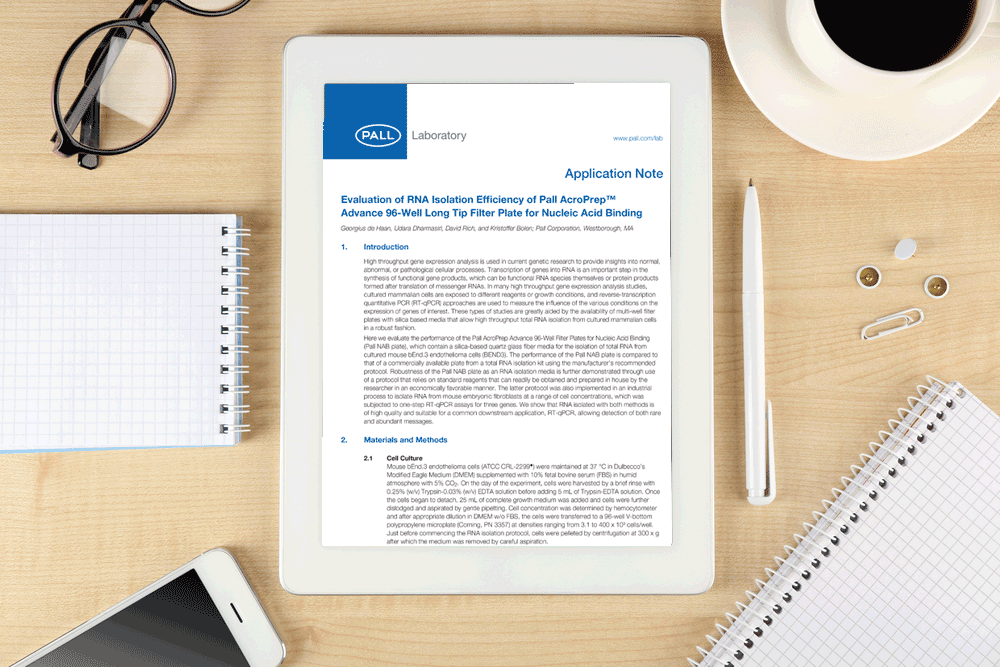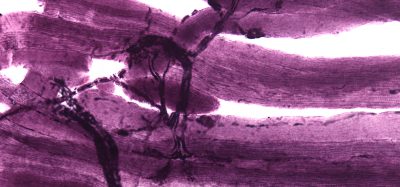App note: Evaluation of RNA isolation efficiency of Pall AcroPrep™ Advance 96-Well Long Tip Filter Plate for Nucleic Acid Binding
Posted: 22 November 2016 | Pall Laboratory | 2 comments
In this application note, Pall Laboratory evaluate the performance of the Pall AcroPrep Advance 96-Well Filter Plates for Nucleic Acid Binding (Pall NAB plate), which contain a silica-based quartz glass fiber media for the isolation of total RNA…
High throughput gene expression analysis is used in current genetic research to provide insights into normal, abnormal, or pathological cellular processes. Transcription of genes into RNA is an important step in the synthesis of functional gene products, which can be functional RNA species themselves or protein products formed after translation of messenger RNAs.
In many high throughput gene expression analysis studies, cultured mammalian cells are exposed to different reagents or growth conditions, and reverse-transcription quantitative PCR (RT-qPCR) approaches are used to measure the influence of the various conditions on the expression of genes of interest. These types of studies are greatly aided by the availability of multi-well filter plates with silica based media that allow high throughput total RNA isolation from cultured mammalian cells in a robust fashion.
Here we evaluate the performance of the Pall AcroPrep Advance 96-Well Filter Plates for Nucleic Acid Binding (Pall NAB plate), which contain a silica-based quartz glass fiber media for the isolation of total RNA from cultured mouse bEnd.3 endothelioma cells (BEND3). The performance of the Pall NAB plate is compared to that of a commercially available plate from a total RNA isolation kit using the manufacturer’s recommended protocol. Robustness of the Pall NAB plate as an RNA isolation media is further demonstrated through use of a protocol that relies on standard reagents that can readily be obtained and prepared in house by the researcher in an economically favorable manner. The latter protocol was also implemented in an industrial process to isolate RNA from mouse embryonic fibroblasts at a range of cell concentrations, which was subjected to one-step RT-qPCR assays for three genes. We show that RNA isolated with both methods is of high quality and suitable for a common downstream application, RT-qPCR, allowing detection of both rare and abundant messages.
This application note is restricted - login or subscribe free to access
 Thank you for visiting our website. To access this content in full you'll need to login. It's completely free to subscribe, and in less than a minute you can continue reading. If you've already subscribed, great - just login.
Thank you for visiting our website. To access this content in full you'll need to login. It's completely free to subscribe, and in less than a minute you can continue reading. If you've already subscribed, great - just login.
Why subscribe? Join our growing community of thousands of industry professionals and gain access to:
- quarterly issues in print and/or digital format
- case studies, whitepapers, webinars and industry-leading content
- breaking news and features
- our extensive online archive of thousands of articles and years of past issues
- ...And it's all free!
Click here to Subscribe today Login here
Related content from this organisation
- Pall Laboratory
- App note: Evaluation of RNA isolation efficiency of Pall AcroPrep™ Advance 96-Well Long Tip Filter Plate for Nucleic Acid Binding
- App note: AcroPrep™ Advance 96-well Long Tip Filter Plate for Nucleic Acid Binding for high-throughput purification of plasmid DNA
- App note: Evaluation of Genomic DNA isolation with AcroPrep™ Advance 96-Well Long Tip Filter Plate for Nucleic Acid Binding
- Whitepaper: Single-tube DNA purification and cloning using ultrafiltration devices
Related topics
High-Throughput Screening (HTS), Polymerase Chain Reactions (PCRs), Real-time polymerase chain reaction (qPCR)
Related organisations
Pall Laboratory






Can I get this paper??
App note: Evaluation of RNA isolation efficiency of Pall AcroPrep™ Advance 96-Well Long Tip Filter Plate for Nucleic Acid Binding
Hi Sun-ho,
You can access the App Note for free by clicking download and filling in the form.